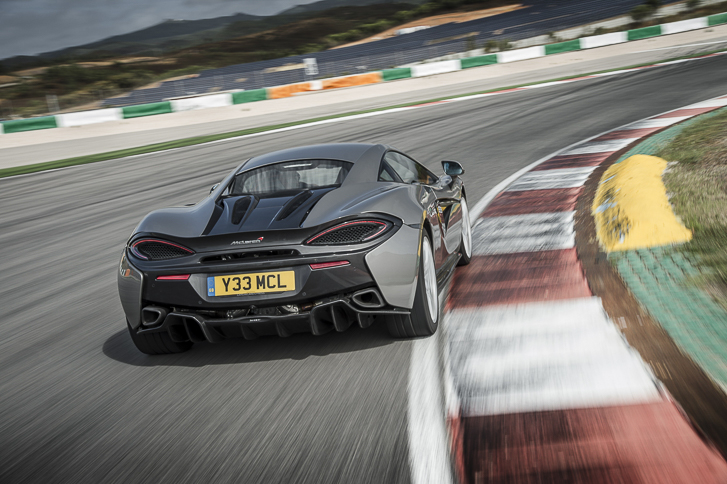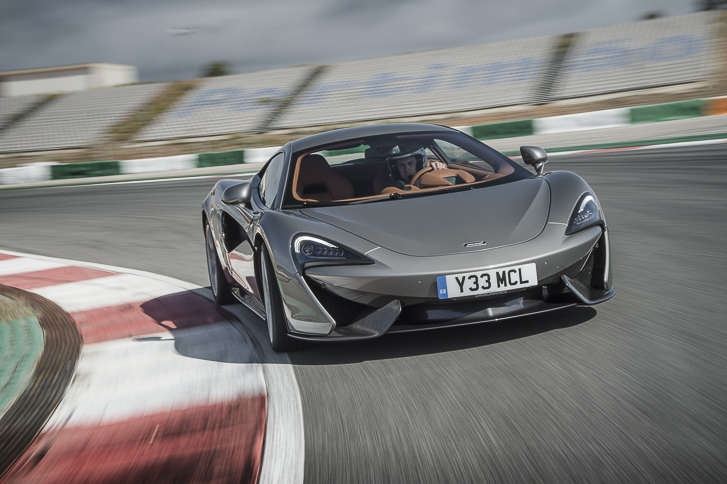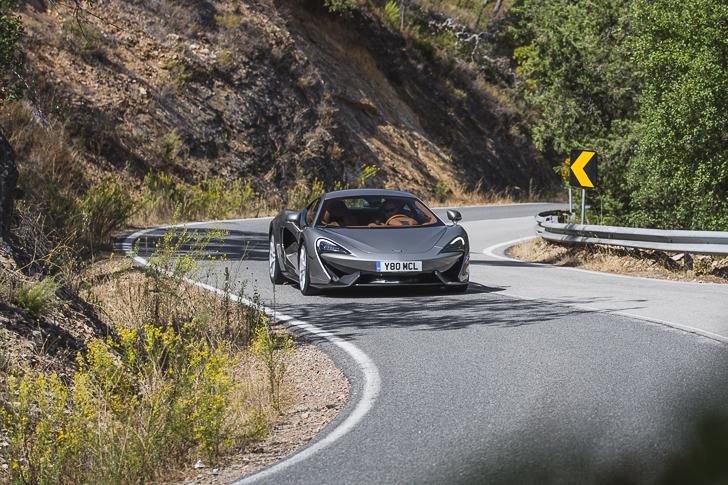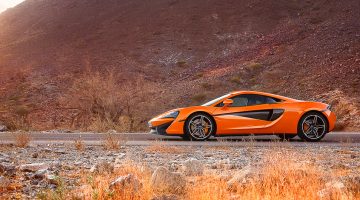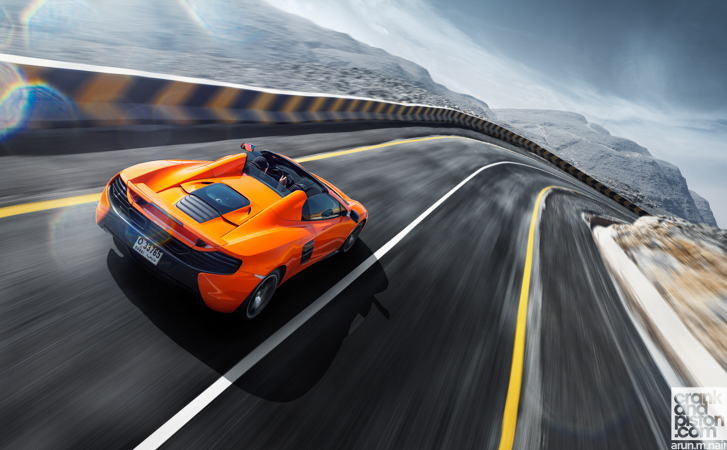According to McLaren, its new ‘entry level’ model is a sports car, not a supercar. It’s also more ‘usable’. What’s going on? crankandpiston.com finds out on the international launch in Portugal
| Engine | Power | Torque | 0-100kph | Top speed | Weight | Basic price |
|---|---|---|---|---|---|---|
| V8, twin-turbo, 3799cc | 562bhp @ 7500rpm | 443lb ft @ 5000-6500rpm | 3.2secs | 328kph | 1313kg (435bhp/ton) | $216,400 |
I’m at a swanky hotel in the Algarve region of Portugal attending McLaren’s media presentation for the brand new 570S, and I’m listening to Woking’s head of PR Wayne Bruce (yes, he’s aware his name is the reverse of Batman’s) tell me that the first member of McLaren’s new Sports-Series range is not a supercar, but an everyday useable sports car. While the delivery of his words is very convincing, the bright orange 570S parked in the background is causing me to doubt the truthfulness of his message. For visually everything about the “baby” McLaren screams supercar. Lurid paint job, check. Scissor doors, check. Low slung swoopy and sculpted styling, check. So far, so supercar.
But if you focus in on the details you start to see that there is some validity to what he is saying. Like all McLarens, the 570S is built around a very light, stiff carbon fibre tub. Called MonoCell II, the chassis is similar to that of big brother 650S but it’s been adapted to improve access to the cabin. Notably, 80mm has been trimmed out of the sill height, and the dihedral motion of those aforementioned doors now follows a more upwards and forwards arc. The result is a considerably bigger opening that makes life a lot easier when climbing in and out. Further nods to practicality are the inclusion of cup holders and a glove compartment for the first time in a McLaren. And while it is the entry-level McLaren it isn’t the smallest: the 570S is actually both longer and wider than the 650S giving it a bigger cabin and more storage space.
Let’s not get carried away though, as the 570S is unlikely to ever be confused for a minivan. The stunning looks will make sure of that. To my eye it is the prettiest car McLaren makes, the proportions and stance a vast improvement on the slightly clumsy styling of the 650S, and the smoother -albeit fussier -lines give it a certain visual delicacy that I find highly attractive.
Improved practicality is all well and good, but I haven’t flown all the way to Portugal to listen to a presentation about cupholders. I’m here to find out if the 570S drives as well as it looks and tomorrow I will get to do that on both road and the exhilarating Portimao race-track. Woking has been on a bit of a roll with the widely acclaimed (and sold out) P1 and 675LT, so expectations are high.
It seems like McLaren have brought the weather with them from Woking, as the morning sky is full of foreboding grey clouds and the roads are slick from intermittent rain showers. The combination of an early start, unpleasant road conditions and the mostly highway commute to the Portimao Circuit means I settle into a 120kph cruise with both the engine and suspension in their Comfort setting. The first thing you notice is that the ride is exemplary, although this has always been a characteristic of McLaren’s since day one. In the case of the 570S it’s a relief as it’s the first modern Woking product that does without the complex ProActive Chassis Control system that links the dampers hydraulically to decouple ride and roll stiffness. Instead the 570S has a more conventional anti-roll bar setup and runs on double wishbones all round with three-way adaptive dampers. Whatever, the result is a calm ride that irons out imperfections, yet doesn’t feel floaty or soft. It may not have the incredible magic carpet glide of the 650S, but the simpler (and cheaper) suspension of the 570S still rides better than most luxury saloons.
“Improved practicality is all well and good, but I haven’t flown all the way to Portugal to listen to a presentation about cupholders”
My relaxed start to the day also gives me a chance to take in the cabin surroundings. The high quality yet minimalist ambience is immediately reminiscent of other McLarens, but with several notable changes from the architecture that we are used to. The most obvious difference is quite literally staring me in the face, and that is the new LCD screen instrument cluster. Meanwhile the centre console that houses the IRIS touchscreen is now floating, giving easy access to the storage area below it. The optional sports seats (there is also a luxury spec available) deserve a special mention as they are not only supportive and perfectly located, they are also very comfortable over a long journey, which is not something you can usually say about fixed-back bucket seats. The seating position is absolutely spot-on, as is outward visibility but this isn’t surprising as McLaren has made a habit of getting these right in the past. I also can’t help but notice how calm and quiet the cabin is, the engine note in the Normal setting is barely audible on a steady throttle.
The Portimao circuit is a huge challenge in perfect weather conditions and is downright terrifying in the wet, which is unfortunately the state we find it in when we get there. The schedule for the day means I only have a handful of laps to get a feel for a 562bhp supercar – oops I mean sports car – in these treacherous conditions. No pressure then. I needn’t have worried though, as it is immediately evident what a well sorted car the ‘baby’ McLaren is, and despite the slick surface, it never feels intimidating. Unlike the far spikier 650S, the transition from grip to slip is far more progressive and controllable and as a result its limits feel more exploitable. The 570S is remarkably throttle adjustable for a turbo-charged car, which allows you to enjoy the superb balance of its rear-wheel-drive chassis.
With my brief track sojourn completed I have an extended road route ahead of me, which should complete the promising initial impressions formed on circuit.
To make things even better the sun has started to peek out from behind the clouds and the surface is rapidly drying. It’s also almost entirely free of traffic. If you’ve ever been to Portugal you’ll know it is blessed with some of the best driving roads in the world that will expose any flaws a car might have. With the chassis switched into its Sport Setting the relaxed ride quality translates to fine pliancy and fluid bump-absorption over the more uneven sections of road. These surfaces would tie a lesser car into knots, but the 570S never feels nervous or fidgety, allowing you to attack an inviting stretch of road with confidence.
The steering, which is a bit light on feedback in wet conditions, comes alive in the dry. It is direct and crisp with a very natural weight and response. The hydraulically assisted rack communicates very clearly what is going on at the front wheels, and combined with a nose that doesn’t seem to know the meaning of the word understeer, you can place the car with a precision that few others can equal. Meanwhile traction at the rear is also excellent despite the lack of a limited-slip differential, but when the backs finally give up the breakaway remains as progressive and adjustable in the dry as it was on a wet track.
While the 570S never quite matches the awe-inspiring hit of acceleration that the 650S delivers, the combination of 1313kg and 562bhp means it’s still a very, very rapid car. The run to the ton is completed in 3.2 seconds and it will keep pulling to 328kph: pinning the throttle out of a corner and onto even the shortest of straights dispels any doubts as to the accuracy of those numbers. After a bit of hesitation at lower revs the turbos wake up and pull cleanly to an 8500rpm crescendo before a pull on the right paddle sees the familiar Seamless Shift Gearbox shift cleanly and rapidly to the next ratio and continue the relentless charge forward. Although I will say (along with the minor turbo-lag) the other slight letdown is in the aural department. This is surprising considering how much emphasis the McLaren engineers at the launch put on how hard they’d worked to make the 570S sound great. Don’t get me wrong it’s not a bad noise, but it lacks the fireworks of the very best sounding sportscars. There are no such complaints about the standard –fit carbon ceramic brakes, which return not only forceful retardation in big stops, but also a high level of sensitivity and feel through the pedal.
“The combination of 1313kg and 562bhp means the 570S is still a very, very rapid car. The run to the ton is completed in 3.2 seconds and it will keep pulling to 328kph”
By entering the crowded sports car arena McLaren is taking on some pretty formidable opposition. The first opponents that come to mind are the Porsche 911 Turbo S and Audi R8 V10, but it will also need to fight the Mercedes AMG GT S, Jaguar F-TYPE R and Nissan GT-R. While that is a murderer’s row of epic sportscars, I can unhesitatingly state that the 570S is fully equipped to take each of them head on. It has lightness on its side, undercutting its nearest rival by a whopping 150kg. It also has the sweetest handling chassis of any of them and a level of usability that is up there with the best of them. Combine that with its dramatic looks and exotic badge and it becomes very easy to make a case for the McLaren. Regardless of whether the 570S is a sports car or a supercar there’s no confusing that it is brilliant.
Technical specifications available on page 2

